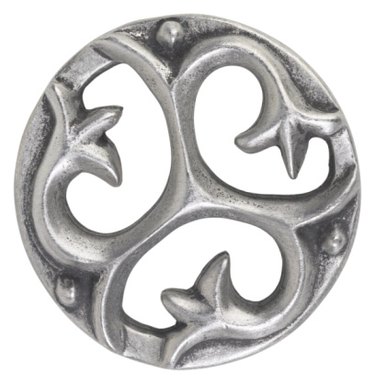Tarnish is the result of a chemical reaction of metals and air. On silver and silver-plated objects, tarnish appears as a thin, soot-colored film. This tarnish is the reaction between silver and hydrogen sulfide in the air. Tarnish is not damaging to the silver object; on the contrary, removing the tarnish with harsh chemicals or overpolishing can harm the silver. Specially formulated silver tarnish remover is expensive and cannot always infiltrate carved grooves and intricate patterns. Use a home recipe using simple household ingredients or a paste method using nonabrasive calcium carbonate to quickly and safely reverse the chemical reaction.

Video of the Day
Things You'll Need
Cotton Balls
Baking Soda
Cotton Cloth Or Towel
Distilled Water
Tongs
Denatured Alcohol Or Ethyl Alcohol
Aluminum Foil
A Large Glass, Stainless Steel Or Enamel Pot
Glass Bowl
Calcium Carbonate Powder
Wooden Spoon Or Skewers
Q-Tips
The Dip Method
Step 1
Wrap the silver object tightly in aluminum foil. Make sure the foil is pressed up against the silver in at least one place.
Video of the Day
Step 2
Tear a few holes in the aluminum foil wrapping, to allow water to seep in through the foil and contact the silver object inside.
Step 3
Place the object in a large pot and cover with water. Put the pot on the stove and turn the burner on high.
Step 4
Add 4 tbsps. of baking soda per quart of water.
Step 5
Allow the water to simmer for 3 to 30 minutes, depending on the severity of the tarnish.
Step 6
Remove the object from the pot with tongs. Place the object on a clean, dry cotton towel.
Step 7
Remove the aluminum foil. Rinse the silver in warm water. Buff dry thoroughly with a clean, dry cotton cloth.
Step 8
Repeat the procedure with fresh foil, water and baking soda if the tarnish remains.
The Polish Method
Step 1
Place a few tablespoons of calcium carbonate into the glass bowl.
Step 2
Add equal amounts of distilled water and denatured alcohol or ethyl alcohol to create a slurry, creamy paste. Stir the paste with the wooden spoon or skewers.
Step 3
Dip a cotton ball in the paste and rub the tarnish from the silver. Use Q-tips to clean grooves or small niches in the silver object.
Step 4
Rinse the silver object with a cotton ball soaked in the alcohol. Rinse gently with distilled water. Dry thoroughly with a clean cotton cloth or towel.
Warning
Do not use a baking soda paste or toothpaste to rub on the silver. These materials are abrasive and will scratch the silver finish.
Do not use an aluminum pot; use only a glass, stainless steel or enamel pot. An aluminum pot will become filled with tarnish from the silver object.
Do not use this technique for mixed metal jewelry, such as gold and silver pieces. Do not use this technique for silver jewelry with gems, as the heat may loosen or damage the jewelry. Take the jewelry to a jeweler for cleaning, or use a commercial silver polishing cream to remove tarnish from the object.
Do not use this technique for oxidized silver or silver with a French gray finish. For these objects, vigorously rub the tarnished silver with a cotton rouge cloth or use a commercially prepared non-abrasive polish for stubborn tarnish.
Use only pure calcium carbonate powder for the polishing method. Do not use chalk, as chalk is abrasive and will scratch the silver finish.